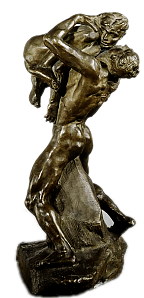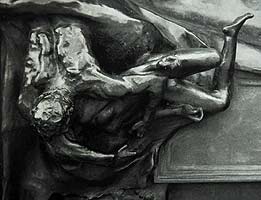|
The model for this work may have been the street
performer Cailloux, a strong man who also posed for 'The
Shade' and possibly for 'Adam'.
 'The
Falling Man' is included in 'The Gates of Hell',
where he rather appears as a 'Climbing Man', attached to the lintel and
the top of the left door. If
Rodin actually planned this element to be fixed both to the left wing and
the box-like tympanum above it, it would have been impossible to open the
door. For this reason, Elsen assumes Rodin positioned this overlapping
figure there only around 1886, after he realised the planned Museum of
Decorative Arts would be not constructed and his 'Gates' would never serve
as a proper doorway. 'The
Falling Man' is included in 'The Gates of Hell',
where he rather appears as a 'Climbing Man', attached to the lintel and
the top of the left door. If
Rodin actually planned this element to be fixed both to the left wing and
the box-like tympanum above it, it would have been impossible to open the
door. For this reason, Elsen assumes Rodin positioned this overlapping
figure there only around 1886, after he realised the planned Museum of
Decorative Arts would be not constructed and his 'Gates' would never serve
as a proper doorway.
Audeh points to a formal similarity of 'The Falling Man'
with Josef Anton Koch's representation of Inferno at the Casino
Massimo in Rome.
Although it could not be verified if Rodin actually was familiar with
Koch's work, Audeh suggests Rodin's 'Falling Man' was derived from Dante's
account about the Barrators (Traitors in Public Office) caught in a
pitch a boiling tar, harrassed by devils with taloned forks, desperately
trying to escape their torment.
|
The 'Falling Man' is repeated in the group 'I Am
Beautiful', now holding the 'Crouching
Woman' in his arms. Edmond de Goncourt described this female
figure as: "a faunesse contracted with her legs gathered in
the astonishing compactness of a frog ready to leap".
The title of the group - propably assigned
afterwards - was derived from a poem by Charles Baudelaire, 'Je
suis belle' in 'Les Fleurs du Mal':
XVII. - La beauté
Je suis belle, ô mortels! comme un rêve de pierre,
Et mon sein, où chacun s'est meurtri tour à tour,
Est fait pour inspirer au poète un amour
Eternel et muet ainsi que la matière.
Je trône dans l'azur comme un sphinx incompris;
J'unis un coeur de neige à la blancheur des cygnes;
Je hais le mouvement qui déplace les lignes,
Et jamais je ne pleure et jamais je ne ris.
Les poètes, devant mes grandes attitudes,
Que j'ai l'air d'emprunter aux plus fiers monuments,
Consumeront leurs jours en d'austères études;
Car j'ai, pour fasciner ces dociles amants,
De purs miroirs qui font toutes choses plus belles:
Mes yeux, mes larges yeux aux clartés éternelles!
|

I am beautiful, O mortals! Like a dream in stone,
And my breast, upon which each is bruised in turn,
Inspires in a poet love silent and eternal
Like that of the material clay flesh and bronze bone
|
This group can be seen in 'The
Gates of Hell' as an element of the bas-relief at the extreme right
side.
Later, it was also worked out and exhibited as an autonomous work.
Between 1898 and 1900, Rodin added a third version 'The
Falling Man' to his monumental lifetime creation: in 'Avarice
and Lust', the upper half of 'The Falling Man' - again with a new
configuration of the arms - is clutching a female figure - later known as 'The
Martyr' - derived from the
upper left corner of the tympanum.
|
 'The
Falling Man' is included in
'The
Falling Man' is included in 
